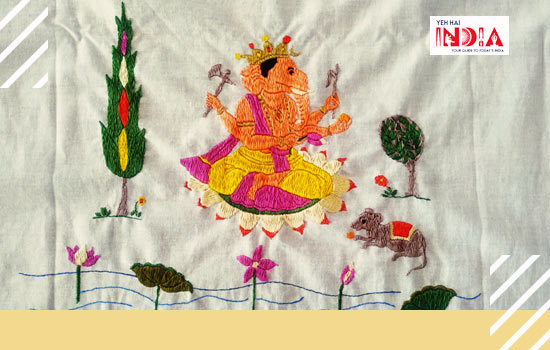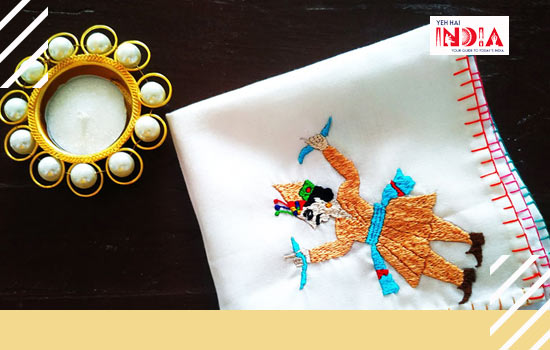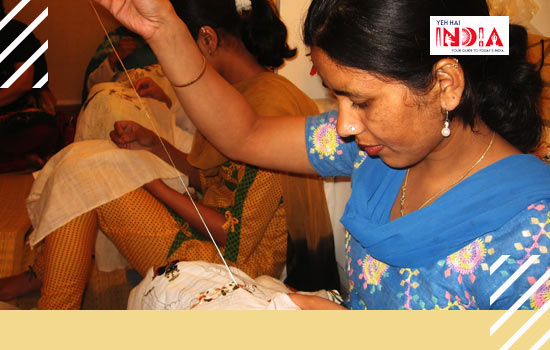Chamba, one of the oldest towns in Himachal Pradesh is known for its authentic art of Chamba Rumaal that has been a significant gift or a token of goodwill.
Chamba Rumaal is a peculiar visual art form inspired from Pahari paintings.
It has pleasing color schemes and bright detailed patterns representing distinctive and delightful embroidery.
Rumaal in Persian language is a square piece of cloth worn on head or around the neck.
For this creation, the cloth employed is generally hand spun and hand woven unbleached mulmul, proceeding with the outline of the designs for embroidery.
Recommended Story – Chamba Chappals of Himachal Pradesh
Chamba Rumaal History

The oldest rumaal date back to 16th century and is believed to be created by Bebe Nanki, sister of Guru Nanak, and is now preserved in the Gurudwara of Gurdaspur.
Through the 17th and 18th century, the craft kept prospering and the miniature Pahari paintings were translated into kashidakari (embroidery).
This later became the famous women craft tradition of Chamba.
In the 17th century, origin and inspiration for rumaal was adopted from Basohli.
King Raja Singh won over Basohli and brought rumaal to Chamba, eventually naming it Chamba Rumaal.
In the 18th century, Chamba rumaal flourished with new motifs and stitches.
Eventually this art started to combine with other crafts to make it a contemporary product.
In the late 19th century, the use of mill cloth was noticed which was brought to Chamba from Punjab by the itinerant traders of Sukho-Chak town in Gurdaspur district.
Design, Motifs and Colors of Chamba Rumaal

The design is majorly inspired by the themes like Radha Krishna RasLeela, Shikargah, Makhhan Leela, Cheerharan Leela, Daan Leela, Mann Leela etc.
Motifs involving flora and fauna are very common like parrots, peacocks, cranes, partridges and sparrows, cows, elephants, horses, deer ,wild boar, dogs, plantains, cypresses, willow trees, shrubs and plants (buti), buds and flowers (phul) patterns.
A floral border which encloses a finely drawn religious scene set using several motifs against a clear background can be commonly found in Chama rumaal.
This craft is a vibrant technique using several variety of colors.
Most commonly used colors are purple, brilliant pink, orange, carmine, deep red brown, lemon and deep yellow dark green, parrot green and green, ultramarine, Prussian blue, black, and white.
Fabric and Stitches of Chamba Rumaal

The cloth used was usually hand spun and hand-woven cotton (khaddar) or fine muslin (mulmul), in off white color, as off white is the best choice to highlight the vibrant embroidery done on the fabric.
The most common fabric used is Khaddar because of its availability, low cost, and durability.
Royal clan of Chamba uses the silk fabric for this craft to present it during a festival or marriage ceremony.
The most common of all the fabrics being used is muslin or the cotton fabric.
The thread used for embroidery is untwisted silk thread and silver wire has also been found on old rumaals.
Common stitches found are Dandi Tanka (the stem stitch), the criss-cross stitch, the buttonhole stitch, the long and short stitch, and the herringbone stitch, as well as pattern darning.
Procedure

Chamba Rumal has pictorial depictions of local customs, festivals, mythological characters, and stories that are inspired by the Pahari paintings.
First, the fabric is selected and cut and the motifs are hand painted by expert miniature painters.
To make the paint, they usually make the lampblack, scrape it off the surface and mix it with gum made of babool and water to get the right consistency.
To get fine lines, squirrel hair brush with a little bend is used .
These days, the design can be printed on sheets and then traced on the fabric using yellow carbon paper.
The colors of the embroidery are predetermined and then the embroidery is done.
Traditional Significance

Embroidered rumaals were customarily gifted in a girl’s marriage, as it was considered an essential dowry item of the bride who imbibed the craft at a very young age.
These rumaals were worn by the men and women by hanging them proudly on their shoulder on weddings or other important occasions.
These were made by every class, rich or poor; high or low, everyone used to produce them in some form or other.
This craft is now characterised as a languishing craft, the folk version of this rumaal continues to be created even today.
They are used for several household purpose and everyday use such as to cover gifts and offerings to the Gods.
Recommended Story – Ajrakh – Craft Created in Harmony with the Nature
Present Scenario of Market

This craft has an aesthetic and appealing market with great potential for the niche market.
As the crafts person involved in this are very limited leading to the discouragement of the craft, it is presently dismal.
They have little or no access to the bigger markets and is majorly found in the small local markets of Chamba.
In an effort to provide livelihoods and encourage the languishing craft, the Central and State Government has also initiated training workshops cum production centres.
They organise 8–12 months trainings but the visibility of enthusiasm is very low.
Conclusion

This craft serves as a lavish charm and attraction of Chamba with bright colors and vibrant designs, singing out stories from the past for the people.
There is a scope of opportunity into the introduction of new product line with changed designs according to the present market needs.
Motifs can be given a twist along with its better placement with alignments and scaling and introduction of new yarns is possible too.
But, at the same time, it is a time consuming, delicate, hard to protect, expensive process and is manufactured in a remote area, exposing itself to a minor part of the population.
The trend of mass production has led machine embroidery to take over hand embroidery.
Due to lack of margin, this art is dying as and many people continue to back out.
Also Read – Chikankari- The Exceptional Art of Embroidery










